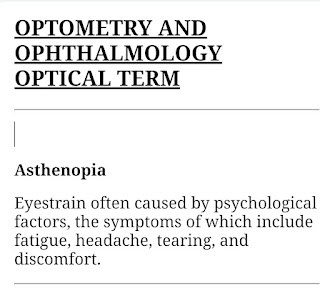OPTOMETRY AND OPHTHALMOLOGY OPTICAL TERM
Asthenopia
Eyestrain often caused by psychological factors, the symptoms of which include fatigue, headache, tearing, and discomfort.
Axon
Part of a neuron that connects to other neurons or cells and transports impulses away from the cell body.
Bipolar cell
A type of neuron in the retina that is connected to ganglions on one end and either one cone cell or multiple rod cells on the other end.
Concave lens
A lens that curves inward, like a bowl.
cone
Cone-shaped light-sensing cell in the retinas of vertebrates that processes colour and detail and converts light into impulses to the optic nerve fibre.
convex lens
A rounded lens that curves outward, like a sphere.
Dendrite
Part of a neuron that typically transports impulses toward a cell body.
Diplopia
Double vision, or perceiving two images of a single object, resulting from the projection of an object’s image onto non-corresponding locations on the retina of each eye.
Emmetropia
Condition in which light rays focus directly on the retina, resulting in normal vision.
Ganglion cell
A type of neuron in the retina that receives input from both rods and cones.
Hyperopia
Farsightedness resulting from the image of a visual field focusing behind the retina.
Innervate
To provide an organ with nerves.
Iuminosity
Brightness or intensity of light projected by a source.
Mesopic
vision Eyesight in medium lighting that is facilitated by both the rods and cones of the retina.
Myopia
Nearsightedness resulting from the image of a visual field focusing in front of the retina.
Nodule
Tissue or cells that have amassed into a hard, protruding growth.
Ophthalmology
Field of medicine concerned specifically with the afflictions and treatment of the eye.
Optic chiasm
X-shaped structure below the hypothalamus where half the optic nerve fibres from each eye cross over to join nerve fibres from the opposite eye on the opposite side of the brain. The remaining half of the fibres continue on the same respective side of the brain.
Orbit
Hollow in the skull for the eye; eye socket.
Photopic vision
Eyesight in bright light that is facilitated by the cones of the retina.
Presbyopia
Loss of elasticity in the eye lens that results in the inability to focus on nearby objects.
Quantum
A small unit of radiant energy, equivalent to the product of Planck’s constant and the frequency of the radiation. refraction Change in a wave’s direction caused by its passage through a different medium and the resultant change in the wave’s velocity.
Rod
Rod-shaped light-sensing cell in the retinas of vertebrates that converts stimuli from photons into electrical and chemical stimuli for the nervous system.
Saccade
Rapid eye movement, often accompanied by a head movement, that shifts the gaze so that the fovea can take in the various aspects of a visual field.
Scotoma
Blind spot or area of the visual field in which vision is severely limited.
Scotopic vision
Eyesight in low light that is facilitated by the rods of the retina.
Stereopsis
Depth perception resulting from the projection of an object’s image, as it is perceived by each eye, to a single hemisphere of the brain.
Torsion
Rotation of an organ on its own axis.
Visual field
Everything visible to a stationary eye at a given moment.

